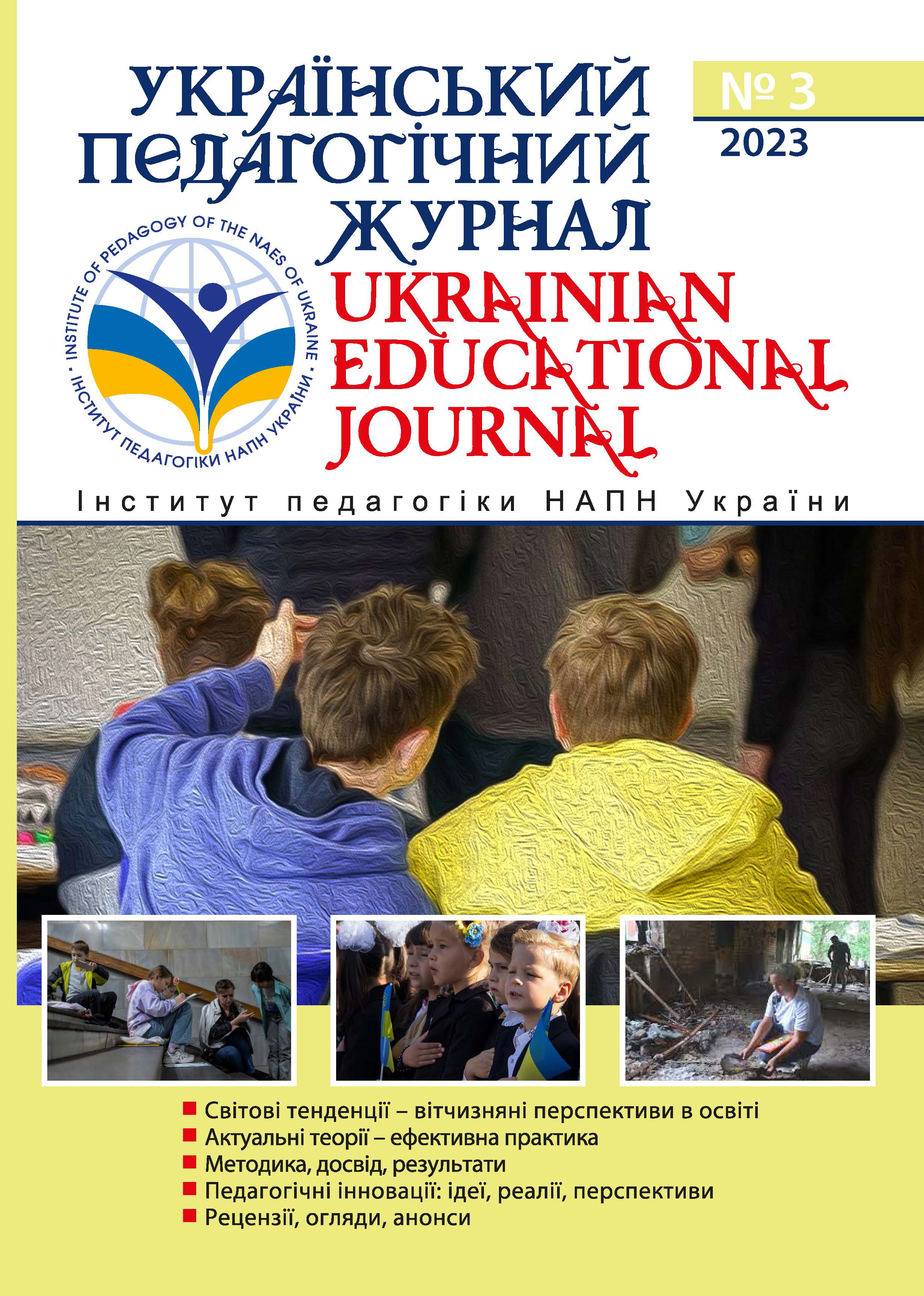Abstract
Based on the analysis of scientific and pedagogical sources, the stages of development of the concept of integration in education are defined and characterized. The terminology and understanding of this concept of the previous stages of development used at each subsequent stage, that is, the understanding of the concept is not reborn, but rather enriched and supplemented with new characteristics. The article describes the peculiarities of the introduction of an integrative approach in modern conditions of widespread use of digital educational resources.
The authors proved that the use of integrated education contributes to the formation of a holistic scientific picture of the world in students, to understanding the place of knowledge from one or another educational subject in the modern technological, information society. The article also presents the requirements for training teachers, which they must have in order to successfully organize the educational process, taking into account the features of integrated learning and the active use of digital technologies in educational activities.
The authors developed and presented in the article a technological scheme for the implementation of integrated learning, according to which the stages of teacher preparation for conducting an integrated lesson are defined. According to this scheme, firstly the object of study is determined, and then the subjects into which the object under consideration can be divided. At the next stage, the educational goals of the integrated educational subjects and the integrated educational goal are determined. Next, the content, means, methods, organizational forms of education in the relevant subjects are selected.
It is advisable to apply the technological scheme of the organization of integrated learning proposed in the study to teachers in the process of preparing for conducting integrated lessons. The given topics for study by future teachers will contribute to the formation and development of the knowledge of students of pedagogical specialties regarding various digital educational resources and understanding the peculiarities of the methodology of the educational process at various stages of lessons with a pedagogically balanced use of digital educational resources based on integrated learning.
References
Засєкіна, Т.М. (2020) Інтеграція в шкільній природничій освіті: теорія і практика: монографія. Київ: Педагогічна думка. https://undip.org.ua/wp-content/uploads/2021/07/monografiya_integrachia-1.pdf
Когут, У.П. (2016) Фундаментальні поняття як інтегративний компонент організації навчання дослідження операцій майбутніх бакалаврів інформатики. Інформаційні технології і засоби навчання, 2 (52), 36 – 51. https://doi.org/10.33407/itlt.v52i2.1380
Лесняк, Н.В. (1997) Міжпредметні зв’язки у формуванні мовленнєвих умінь майбутніх учителів початкових класів: дис…канд. пед. наук: 13.00.02. Рівне. Рівненський державний педагогічний інститут.
Нова українська школа: концептуальні засади реформування середньої школи (2016). https://mon.gov.ua/storage/app/media/zagalna%20serednya/nova-ukrainska-shkola-compressed.pdf
Сакалюк, О.П., Стефунько, Л.І. (2020) Складові компоненти підготовки майбутніх учителів до реалізації інтегрованого навчання у початковій школі. Молодий вчений, 3 (79). https://doi.org/10.32839/2304-5809/2020-3-79-85
Тарасова, Т.В. (2018) «Екологія і діалектика»: до 30-річчя педагогічної технології. Педагогічні науки: теорія, історія, інноваційні технології. 4, 378 – 396. http://nbuv.gov.ua/UJRN/pednauk_2018_4_35
Філософський енциклопедичний словник (2002). Київ: ВГЛ «Абрис».
Hawkey, K., James, J., & Tidmarsh, C. (2019). Using Wicked problems to foster interdisciplinary practice among UK trainee teachers. Journal of Education for Teaching, 45(4), 446–460. https://doi.org/10.1080/02607476.2019.1639263
Juraev, M. M. & Aroyev D. D. (2023). Interdisciplinary integration is an important part of developing the professional training of students. Open Access Repository, 9(1), 93–101. https://doi.org/10.17605/OSF.IO/H85SF
Lenoir, Y., & Hasni, A. (2016). Interdisciplinarity in primary and secondary school: Issues and perspectives. Creative Education, 7(16), 2433–2458. https://doi.org/10.4236/ce.2016.716233
Michelsen, C., & Sriraman, B. (2009). Does interdisciplinary instruction raise students’ interest in mathematics and the subjects of the natural sciences? ZDM, 41(1–2), 231–244. https://doi.org/10.1007/s11858-008-0161-5
Ríordáin, M. N., Johnston, J., & Walshe, G. (2016). Making mathematics and science integration happen: Key aspects of practice. International Journal of Mathematical Education in Science and Technology, 47(2), 233–255. https://doi.org/10.1080/0020739X.2015.1078001
Samson, G. (2014). From Writing to Doing: The Challenges of Implementing Integration (and Interdisciplinarity) in the Teaching of Mathematics, Sciences, and Technology. Canadian Journal of Science, Mathematics and Technology Education, 14(4), 346–358. https://doi.org/10.1080/14926156.2014.964883
Tonnetti, B. & Lentillon-Kaestner, V. (2023). Teaching interdisciplinarity in secondary school: A systematic review, Cogent Education. https://doi.org/10.1080/2331186X.2023.2216038
Zasyekina, T.M. (2020) Integraciya v shkil`nij pry`rodny`chij osviti: teoriya i prakty`ka: monografiya. Ky`yiv: Pedagogichna dumka. https://undip.org.ua/wp-content/uploads/2021/07/monografiya_integrachia-1.pdf (in Ukrainian).
Kogut, U.P. (2016) Fundamental`ni ponyattya yak integraty`vny`j komponent organizaciyi navchannya doslidzhennya operacij majbutnix bakalavriv informaty`ky`. Informacijni texnologiyi i zasoby` navchannya, 2 (52), 36 – 51. https://doi.org/10.33407/itlt.v52i2.1380 (in Ukrainian).
Lesnyak, N.V. (1997) Mizhpredmetni zv'yazky` u formuvanni movlennyevy`x umin` majbutnix uchy`teliv pochatkovy`x klasiv: dy`s…kand. ped. nauk: 13.00.02. Rivne. Rivnens`ky`j derzhavny`j pedagogichny`j insty`tut. (in Ukrainian).
Nova ukrayins`ka shkola: konceptual`ni zasady` reformuvannya seredn`oyi shkoly` (2016). https://mon.gov.ua/storage/app/media/zagalna%20serednya/nova-ukrainska-shkola-compressed.pdf (in Ukrainian).
Sakalyuk, O.P., Stefun`ko, L.I. (2020) Skladovi komponenty` pidgotovky` majbutnix uchy`teliv do realizaciyi integrovanogo navchannya u pochatkovij shkoli. Molody`j vcheny`j, 3 (79). https://doi.org/10.32839/2304-5809/2020-3-79-85 (in Ukrainian).
Tarasova, T.V. (2018) «Ekologiya i dialekty`ka»: do 30-richchya pedagogichnoyi texnologiyi. Pedagogichni nauky`: teoriya, istoriya, innovacijni texnologiyi. 4, 378 – 396. http://nbuv.gov.ua/UJRN/pednauk_2018_4_35 (in Ukrainian).
Filosofs`ky`j ency`klopedy`chny`j slovny`k (2002). Ky`yiv: VGL «Abry`s». (in Ukrainian).
Hawkey, K., James, J., & Tidmarsh, C. (2019). Using Wicked problems to foster interdisciplinary practice among UK trainee teachers. Journal of Education for Teaching, 45(4), 446–460. https://doi.org/10.1080/02607476.2019.1639263 (in English).
Juraev, M. M. & Aroyev D. D. (2023). Interdisciplinary integration is an important part of developing the professional training of students. Open Access Repository, 9(1), 93–101. https://doi.org/10.17605/OSF.IO/H85SF (in English).
Lenoir, Y., & Hasni, A. (2016). Interdisciplinarity in primary and secondary school: Issues and perspectives. Creative Education, 7(16), 2433–2458. https://doi.org/10.4236/ce.2016.716233 (in English).
Michelsen, C., & Sriraman, B. (2009). Does interdisciplinary instruction raise students’ interest in mathematics and the subjects of the natural sciences? ZDM, 41(1–2), 231–244. https://doi.org/10.1007/s11858-008-0161-5 (in English).
Ríordáin, M. N., Johnston, J., & Walshe, G. (2016). Making mathematics and science integration happen: Key aspects of practice. International Journal of Mathematical Education in Science and Technology, 47(2), 233–255. https://doi.org/10.1080/0020739X.2015.1078001 (in English).
Samson, G. (2014). From Writing to Doing: The Challenges of Implementing Integration (and Interdisciplinarity) in the Teaching of Mathematics, Sciences, and Technology. Canadian Journal of Science, Mathematics and Technology Education, 14(4), 346–358. https://doi.org/10.1080/14926156.2014.964883 (in English).
Tonnetti, B. & Lentillon-Kaestner, V. (2023). Teaching interdisciplinarity in secondary school: A systematic review, Cogent Education. https://doi.org/10.1080/2331186X.2023.2216038 (in English).

This work is licensed under a Creative Commons Attribution-NonCommercial-ShareAlike 4.0 International License.


